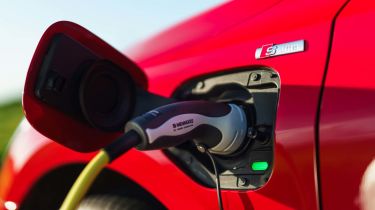Audi A3 hybrid range, MPG, CO2 & charging
The A3 TFSI e compares well with its Mercedes A-Class rival in this regard, but you need to stick to 17-inch wheels if you want the best figures
| Model | Fuel economy | CO2 emissions | Electric range | Wallbox charge time |
|---|---|---|---|---|
| 40 TFSI e | 283mpg | 29g/km | 40 miles | 4hrs 30mins (0-100%, 2.9kW) |
| 45 TFSI e | 235mpg | 25g/km | 37 miles | 4hrs 30mins (0-100%, 2.9kW) |
As is the case with all plug-in hybrids, the A3 TFSI e posts very impressive 'on-paper' numbers for both fuel economy and CO2 emissions. As is also the case with all plug-in hybrids, however, those numbers can be nigh-on impossible to replicate in real-world driving.
That's not to say the plug-in A3 is inefficient, though: its decent electric range means you won't use any fuel at all on local shopping trips or school runs, as long as you're able to charge it up overnight at home. And its official figures translate to very low Benefit-in-Kind (BiK) rates for company-car drivers.
Audi A3 hybrid range, MPG & CO2 emissions
In entry-level Sport guise with 17-inch alloy wheels, the A3 TFSI e just about hits the 40-mile electric range threshold for an ultra-low 8% company-car tax rating. The higher trim levels can be specced with these smaller wheels, too, but if you prefer the sportier look of 18-inch rims, the official electric range drops to 37 miles, putting the car into the higher 12% BiK band. That's not a vast difference in the big scheme of things, so some may be happy to pay extra for better-looking wheels.
In the freezing cold and wet conditions of our initial test drive, the A3 was on course to achieve about 80% of its claimed range in electric mode. However, it's worth remembering that variation in range with temperature is a trait common to all electric and plug-in hybrid cars, due to how the material in their batteries behaves.
Charge time
The A3 TFSI e is intended to be topped up at home overnight from a wallbox charger (or even a regular domestic socket if you're stuck). As such, it doesn't have the rapid-charging capability common to pure-electric cars, but it's far from alone among plug-in hybrids in this regard. Replenishing the battery should take no more than four or five fours, leaving you fully charged for the next morning's journey.



